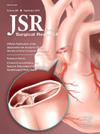Comparing Perspectives About the Informed Consent Conversation for Laparoscopic Cholecystectomy
IF 1.7
3区 医学
Q2 SURGERY
引用次数: 0
Abstract
Introduction
Cholecystectomy is one of the most common operations performed. However, there is no consensus regarding the baseline level of detail to be communicated to patients to constitute truly informed consent. The purpose of this study is to compare attending to resident perspectives of the details deemed essential to the informed consent conversation surrounding laparoscopic cholecystectomy.
Methods
Attending surgeons performing laparoscopic cholecystectomies (n = 60) and general surgery residents (n = 105) from three institutions were invited to participate in this study. An electronic survey was distributed to all surgeons assessing the background knowledge, risks, benefits, alternative options, and postoperative expectations that surgeons believe should be routinely communicated to patients undergoing laparoscopic cholecystectomy for gallstone disease.
Results
Response rates were 57.4% and 38.1% for attending surgeons and residents, respectively. There were no differences of opinions regarding discussing the risks of bleeding, infection, bile leak, retained stones, bowel injury, potential need for intraoperative cholangiogram, or conversion to an open operation. Seventy-four percent of attendings reported that the potential need for postoperative endoscopic retrograde cholangiopancreatography should be discussed compared to 37.5% of residents (P = 0.001). All attending surgeons believe biliary tree injury should be communicated as a surgical risk compared to 85% of residents (P = 0.017).
Conclusions
This study identifies gaps in resident understanding of what is essential to communicate to patients prior to cholecystectomy compared to experienced surgeons. These results suggest areas for improvement in resident comprehension of the importance of discussing the risk of bile duct injury and in the role of endoscopic retrograde cholangiopancreatography for patients with benign biliary disease. The findings of this study advocate for structured and deliberate training programs focused on the informed consent process.
腹腔镜胆囊切除术知情同意对话的观点比较
胆囊切除术是最常见的手术之一。然而,关于向患者传达构成真正知情同意的基线细节水平尚无共识。本研究的目的是比较主治医生和住院医生对腹腔镜胆囊切除术知情同意谈话的细节的看法。方法邀请三所医院的腹腔镜胆囊切除术主治医师(60例)和普外科住院医师(105例)参与本研究。一份电子调查分发给所有外科医生,以评估外科医生认为应常规告知因胆结石疾病接受腹腔镜胆囊切除术的患者的背景知识、风险、益处、替代方案和术后期望。结果主治医师和住院医师的应答率分别为57.4%和38.1%。在讨论出血、感染、胆漏、结石残留、肠损伤、术中胆道造影的潜在需要或转开腹手术的风险方面,没有意见分歧。74%的主治医生报告说,术后内窥镜逆行胰胆管造影的潜在需要应该讨论,而住院医生的这一比例为37.5% (P = 0.001)。与85%的住院医师相比,所有主治医师都认为胆道损伤应作为手术风险进行沟通(P = 0.017)。结论:本研究发现,与经验丰富的外科医生相比,住院医生在胆囊切除术前与患者沟通的必要性方面存在差距。这些结果提示住院医师对讨论胆管损伤风险的重要性以及内镜逆行胆管造影在良性胆道疾病患者中的作用的理解有待改进。这项研究的结果提倡以知情同意过程为重点的结构化和深思熟虑的培训计划。
本文章由计算机程序翻译,如有差异,请以英文原文为准。
求助全文
约1分钟内获得全文
求助全文
来源期刊
CiteScore
3.90
自引率
4.50%
发文量
627
审稿时长
138 days
期刊介绍:
The Journal of Surgical Research: Clinical and Laboratory Investigation publishes original articles concerned with clinical and laboratory investigations relevant to surgical practice and teaching. The journal emphasizes reports of clinical investigations or fundamental research bearing directly on surgical management that will be of general interest to a broad range of surgeons and surgical researchers. The articles presented need not have been the products of surgeons or of surgical laboratories.
The Journal of Surgical Research also features review articles and special articles relating to educational, research, or social issues of interest to the academic surgical community.

 求助内容:
求助内容: 应助结果提醒方式:
应助结果提醒方式:


